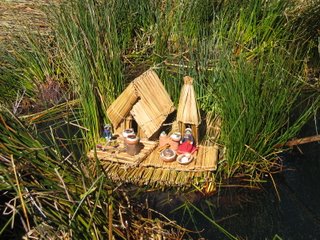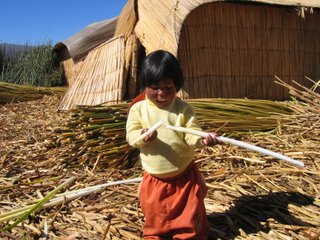
We made our way from Cuzco to Puno in what our travel agent described as the "non-tourist" bus. We later discovered that this meant no AC, no bathrooms in the bus, and hordes of local travelers (most of whom sat themselves along the aisles when the seats got full). It was nearly sunset when we drove along the incredible Peruvian countryside painted with green hills and tiny villages cramped with red roofs. The church is always the tallest building and Incan trapezoidal doors, built as such for good luck, characterize most homes. Plump women in fluffy black embroidered skirts and typical Peruvian hats briskly drive the cattle home. They all have multi-colored shawls strapped across one shoulder lugging everything from children to lambs to handicrafts to vegetables. Little children play outside without a care in the world. Painted on mud walls, ads for Inca Cola and Cusquena beer rush by.
No one announces names of the stops. Nervous about missing ours, we make it a point to ask the locals every time the bus halts and hop off when we reach Puno. We spent the night at a hospedaje run by a most delightful lady who, later, walked us right into downtown in search of dinner and, much later, packed us into bed with hot water bottles. She talked about the harsh weather in Puno, the Quechua people who inhabit the area, and how we’re the first hindu guests she’s proudly hosting.
True to tradition, our tour van collects us next morning and takes us to Lake Titicaca. En route, we stop off to buy fruits, candy, water, and other supplies that are scarce on the islands we’re touring for the next couple of days. Our first view of the highest navigable lake in the world is devoid of any wonder. Looks ordinary enough, except that we’re at an altitude of 3000 meters. Along with Julio, our guide, and fifteen other travelers, we set sail for Uros or the floating islands on this gorgeous day.
We gasp as we spot clusters of golden islands floating on crisp blue waters of the lake. Platforms of reed or tall dried grass support five to seven huts each. Local women greet us in Quechua as we step onto the surprisingly stable 20X20 island. We settle down in a circle on the straw floor while Julio talks about the Uros and its people. A layer of the dried reed is added to the island floor each week to thicken its base and keep the islands dry. The islands themselves last around twenty years after which the families move onto new ones. To ensure that the islands don’t float away to Bolivia, or the "caca" side as Julio jokes, they are hoisted upon firm stakes. It’s almost like a city on water, with floating neighborhoods.

Julio serves us the local snack called the "island banana" which closely resembles a sugar cane but tastes like… well… nothing. Our eyes are drawn towards the poori-like bread that an elderly woman is frying in the open. She uses earthenware for cooking and an earthen stove fired up using … you guessed it… dried reed.

Dotting the surrounding waters are long reed boats in fancy shapes to navigate from one floating island to the other. A dollar a pop transports us to the largest island in the bobbing city. We’d heard that the islands were floating tourist traps with the locals swarming visitors and forcing them to buy handicrafts. To the contrary, we don’t feel harassed at all and thoroughly enjoy the experience.
Nature and people continue to amaze us as we embark on a long three-hour cruise to the volcanic island of Amantani.

No comments:
Post a Comment